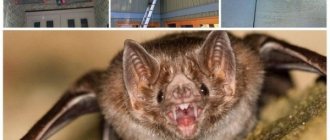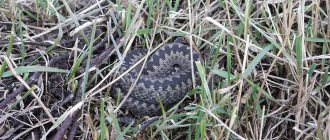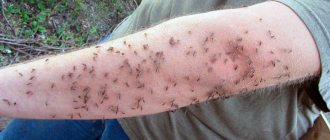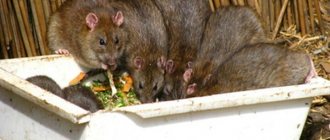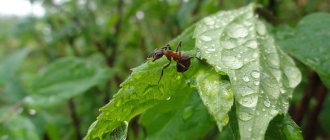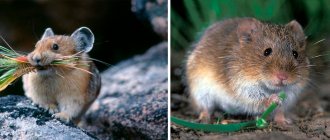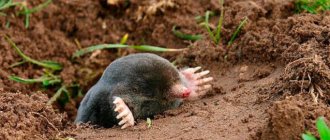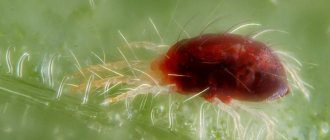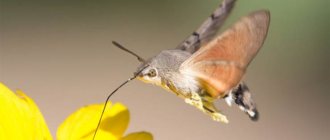The summer season is the time to relax in nature! Cottage, vegetable garden, fishing, going to the forest to pick mushrooms, picnic by the river and much more. etc. But gadflies and horseflies can prevent you from enjoying such a pleasant pastime. These flying insects can not only annoy you with their intrusiveness, but also bite painfully. Compared to them, midges and mosquitoes are “flowers.” In addition, gadflies and horseflies cause great harm to livestock and farming, reducing milk yield and weight gain.
horsefly in the photo
How to protect yourself from the attacks of these huge flies? Let’s say right away that different means can come to your aid. We will tell you about the most effective and popular ones now.
Chemicals
To protect themselves from various vermin (midges, mosquitoes, mosquitoes, etc.), people actively use chemicals. Naturally, there are also drugs that help repel gadflies and horse flies.
Most often in the fight against these insects they use:
- Organophosphorus preparations (dichlorvos, karbofos, tetraphos). Their active substances penetrate the body of insects, where they are converted into dangerous toxins that have a nerve-paralytic effect.
- Pyrethroids (bioallethrin, fenvalerate). They can destroy insects even at the egg-laying and larval stages. They are often used to treat pastures, plots, vegetation along water bodies, etc., to prevent the proliferation of gadflies and horse flies.
- Chlorine-containing drugs (lindane, chlorvinphos, methoxychlor). They are used to treat affected areas of animals for disinfection purposes. They are highly bactericidal. Apply using a spray bottle.
What chemical contact agents against horse flies and gadflies can come to the rescue when it is necessary to protect livestock? This:
- antifly;
- hypodectin;
- chlorophos;
- biofly pur-on;
- sanofit;
- butox, etc.
They must be used according to the instructions. Moreover, some drugs should be administered in the form of injections, while others need to be treated with the skin of animals.
In turn, aerosols and creams based on the substance DEET provide good protection for humans from gadflies and horseflies. The main thing is that its content in the preparation is at least 20%. Otherwise, the remedy will be ineffective.
As for specific repellents that we can recommend, they are:
- Aerosol Picnic. Repels gadflies and horse flies within 2-3 hours after treatment. Can be used no more than twice a day. Also protects against mosquitoes, ticks and midges.
- Aerosol and spray Argus. Duration of action is about 4 hours. It can be used on exposed areas of the body and clothing. The cost is more than acceptable - about 100 rubles.
- Repellents OFF. You can buy it not only on the Internet and specialized outlets, but also in almost any household chemicals store. A very popular line of effective products against blood-sucking insects. To repel horseflies, horseflies and ticks, OFF Extreme aerosol is often used. Price – from 250 rubles. The duration of action is quite decent. If you have treated the skin, then protection is provided for 4 hours; if you have treated clothes, then about a month.
A number of other products from other brands are also capable of repelling horse flies and gadflies. These are Fumitox, Moskitol, Reftamide, DEET, etc. So you can use them too. But in any case, carefully read the instructions and information on the drug packaging, because many of them cannot be used by pregnant women and children.
Gadflies
Members of the family Oestridae are found on all continents of the northern hemisphere, mainly between 25° and 60° latitudes. There are about 176 species of gadflies known in the world, and only one of them, Dermatobia hominis, living in Central America, parasitizes humans. The lifespan of gadflies is 3-5 weeks.
What does a gadfly and its larva look like?
Adult gadflies, 10-25 mm long depending on the species, resemble flies in appearance. Gadflies have large compound eyes, dim colors of different shades. Some resemble bumblebees due to their furry bodies and stripes. There are small antennae on the head. The proboscis is absent or greatly reduced.
Gadfly
Features of the life cycle of the gadfly
All members of the family Oestridae are highly specialized for parasitism. The life cycle of botflies varies greatly depending on the species, but the larvae of all are internal parasites of mammals.
In adult individuals, due to adaptation to parasitism, only rudimentary parts of the oral apparatus remain. Therefore, they cannot feed during their short lifespan, which can be as little as five days (unlike horseflies, gadflies do not bite). The gadfly larva absorbs a large amount of food in the animal's body in order to stock up on nutrients necessary for the life and reproduction of the imago (adult).
Gadflies are capable of flying long distances in search of partners and hosts for their larvae. Depending on the method of laying eggs and the life cycle, they are divided into several subfamilies. The following are common in Russia:
- subcutaneous gadflies (the most numerous is the bovine gadfly, Hypoderma bovis). The female lays eggs on the skin or fur of the animal. Bodfly larvae gnaw into the skin, then gradually migrate to the back as they grow, causing myiasis. Under the skin, the larvae form fistulas for air intake, then pupate and leave the host’s body through the holes made;
- nasopharyngeal gadflies (Rhinoestrus purpureus, Oestrus ovis). The female gives birth to larvae, which in flight are sprayed into the nostrils or eyes of livestock or humans. Gadfly larvae parasitize in the eyeball, nasopharynx, and in the cavities of the frontal bones.
- gastric (a typical representative is Gasterophilus intestinalis). Females lay eggs on the head or limbs of the animal, on the grass of pastures. Gadfly larvae move along the skin to the stomach, or enter it with food. The host's body is discarded with feces. Causes ulcers and catarrh in the stomach.
Why is the gadfly dangerous?
Without the massive use of insecticides to combat these insects, they can cause significant harm to agriculture, especially dairy production. Decrease in milk yield during the active summer of gadflies - by 15-20%, weight gain - by 30-40%.
Skins perforated by larvae are unsuitable for further use (almost every tenth). Accumulations of cavitary botfly larvae often lead to the death of the host animal. Individuals migrating in the body also damage the meat.
WHAT HAPPENS IF YOU ARE BITTE BY A GADDY OR BOARD FLAD
Watch this video on YouTube
Folk remedies for gadflies and horseflies
People have been suffering from horseflies and gadflies for hundreds, or even thousands of years. However, previously there were no chemicals, repellents or traps against these dangerous insects. Man had to come up with and try various protective measures in order to protect himself and his livestock. Some of them turned out to be very effective.
What folk methods of dealing with these bloodsuckers can help? Well, there are several of them:
- Tar. Its smell repels a variety of insects. You can buy it in pharmacies or specialty stores. To protect against horse flies and gadflies, an oil or water solution is used. As a rule, it is simply sprayed on livestock. Some do differently and wash animals with tar soap. However, this method also has disadvantages. Firstly, due to the use of tar, the taste of milk deteriorates (if used on cows). Secondly, this substance is difficult to wash off from skin and clothing. Thirdly, after treatment the protective effect lasts no more than four hours. Moreover, this is subject to complete absence of contact with water.
- Soap and vegetable oil. A solution is made from these components. Optimal proportions: dissolve 1 bar of laundry soap in a liter of water and add 150 ml of vegetable oil. The resulting mixture should be sprayed on the bodies of the cows. As a result, the oil protective film will reduce the spread of odor, which attracts horse flies. In turn, the aroma of laundry soap will repel insects so that they do not bite you or animals.
- Vishnevsky ointment . This product is suitable for protecting humans from horsefly and gadfly bites. It should be applied to exposed areas of the body. For example, hands. Insects are afraid of the smell of Vishnevsky ointment, as it contains birch tar, xeroform and castor oil. In addition, this remedy helps with severe bites of gadflies and horse flies. It is enough to smear it on the affected area and secure the area with a gauze bandage. Such a compress will help draw out pyogenic masses, clean wounds and prevent the formation of scars.
- Diesel fuel. Used against gadflies and horse flies. True, only to protect livestock. It is not recommended to treat human skin with diesel fuel. Validity period is about 2-3 hours. Apply the product to the udder, neck, areas behind the ears and croup.
- Herbal infusions. The safest of folk remedies. And for both humans and animals. There are a lot of options for herbal infusions against horse flies and gadflies. The most popular ones are made from laurel, tansy, mint, lemon and wormwood. Using such products is simple - just apply them to clothing, human or animal skin using a spray bottle.
Of course, there are more traditional ways to combat horse flies and gadflies. We talked about the most popular ones. Try using one of them.
However, keep in mind that folk remedies are ineffective if there are a lot of insects. They will not help with a large number of livestock. Therefore, it is best to use them in combination with chemicals or special traps. By the way, we’ll talk about the latter further.
Gadflies and horse flies do not like the smell of pine needles. Therefore, when going outdoors, treat your clothes with pine oil. If you need to protect livestock, then spruce branches can simply be spread around the area where the animals are.
Why is a horsefly bite dangerous?
Horsefly vinegar is accompanied by severe pain. Insects are very intrusive and difficult to drive away from an animal or person. Horseflies navigate mainly by sight, so you can run away from them.
After a horsefly bite, a lump forms and the surrounding skin turns red. Blood can ooze from the wound for a long time without clotting. The person feels itching and burning. In normal cases, symptoms disappear after a few days.
Allergy to a horsefly bite is a fairly rare occurrence. Sensitive people may develop local swelling, severe redness and itching, rash, deterioration in health, and increased body temperature. Possibly enlarged regional lymph nodes. Subsequently, a hard, painful nodule sometimes forms at the site of the bite, which is typical of an infected wound.
Any poisoning of the body after a horsefly bite or the development of severe allergic reactions (systemic edema, anaphylactic shock) have not been observed in practice.
However, you should know that when bitten, a horsefly can serve as a mechanical carrier of blood-borne diseases:
- anthrax;
- tularemia;
- filariasis.
Mechanical methods
Today on sale you can find various traps for horseflies, gadflies and other large biting insects. Of course, you can’t take them with you fishing or for a walk in the park, but you can and should use such products at dachas and farms.
horsefly trap
- The simplest and cheapest option is adhesive tape . It is hung in agricultural premises, livestock pens, on door frames, summer kitchens, etc. The disadvantages of such a trap are its low efficiency and the impossibility of using it in the open air, pastures, etc. In addition, you need to regularly change the tape to a new one.
- A more effective remedy for horse flies and gadflies is a trap with bait . There are many models that differ in design and size. Although the principle of their action is similar - to lure horse flies, gadflies or other flying insects and prevent them from getting out of there. As for the bait, visual decoys, attractants and heat sources are most often used in such traps. They all imitate a living creature. Advantages: environmentally safe for people and animals, and also very effective and durable when used correctly. Disadvantages: The trap must be cleaned and disinfected periodically.
- Trap package. Another device for catching horseflies and gadflies. Usually hung outdoors, in the sun. The fact is that the smell of the filler (attractant) intensifies when heated, attracting a large number of insects. Once inside the bag, the flying bloodsuckers can no longer get out. Moreover, a thousand individuals can fit here. The advantages of such a trap are safety and ease of use. There is no need to clean or process anything - the bag with the gadflies and horseflies that got into it can be thrown away or burned.
- Illuminated trap. All insects fly towards the light. Gadflies and horse flies are no exception. Therefore, today traps with ultraviolet illumination are being actively created and used. True, their cost is much higher than that of the options described above.
Many traps for horseflies and gadflies are made independently with your own hands. There is nothing complicated. If you want to know how to make them, you can find all the detailed information here. At the same time, we note that insect traps made at home are often even more effective than store-bought ones.
When going outdoors, don’t forget about the simplest personal protective equipment against horseflies and gadflies. These are clothes that cover the entire body well (long sleeves, pants with elastic at the bottom, gloves, a hat, etc.). Remember that these bloodsuckers are attracted to dark colors. Therefore, try to avoid it when choosing things.
Traps for controlling horseflies
You can make a simple but effective trap using improvised means. You don’t need a lot of intelligence here, you just need to know what horseflies prefer, what they don’t like, and you’re done. They can be:
- Light . These traps have a great effect. Charging comes from a solar battery, less often you can charge from batteries. Horseflies fly towards the bright light that comes from this trap and when the pest lands on it, the horsefly receives an electric shock. By the way, this trap is designed not only for catching horse flies, but also other buzzing insects. You can hang it wherever you want (under a canopy, on the porch or in another convenient place).
- Flycatcher paper. The easiest way to get rid of horse flies in the house, but not in the area itself. Sticky tape is applied to the paper, as a result of which horseflies and other buzzing flies, when they get on the sticky base, stick their paws to it.
- Traps are packages. The device helps to catch not only horseflies, but also flies. Pests easily fly into the bag using the bait, but only a few manage to get out. The rest die inside the package.
Complex design
In places with a large concentration of pests, you can come up with this type of trap: a chair must be hung as high as possible from the ceiling, a dark-colored ball is tied to it, the lower part of the chair should be smeared with glue, or double-sided tape should be glued to the surface.
The system works like this: the ball sways and attracts horseflies and flies with its movement. The insect, having flown up to the ball, realizes that there is nothing edible here and flies upward, where it sticks tightly to the sticky layer. It is necessary to periodically renew the sticky layer.
Artificial puddles
Everyone knows that horseflies are terribly fond of drinking water. When they see a puddle, they dive into it at high speed, swallow a certain amount of water and continue their flight.
It is necessary to pour kerosene or gasoline into the “invented” puddles. When the horsefly dives into the puddle at speed, it will clog its spiracles and die.
Bottle traps
This is a fairly simple method, thanks to which you can make many such traps and place them around the entire perimeter of the site. You need to take a bottle, cut off the neck and grease the edges with vegetable oil, then you need to pour in something sweet (syrup, jam). The cut neck is turned over and inserted inside the bottle. The next step is to wrap everything with tape and thread the rope.
All these traps will not help you exterminate pests enormously, but more victims will fall for the baits you create with your own hands. You should also remember that only adult individuals can be caught with traps. They are unable to destroy larvae and eggs.
Insecticidal lamps
You can protect yourself from horseflies and gadflies using insecticidal lamps. These devices work on the following principle: light attracts insects, and an electrical discharge kills them. Such lamps are used on farms, residential complexes, shops, offices, warehouse areas, personal plots and other places. The range of the device is 100-150 square meters. meters.
The average cost of such lamps varies from 2 to 6 thousand rubles. In principle, these are inexpensive, considering how effective they are in controlling flying insects.
Prevention and common mistakes: what else is important to know about the fight against gadflies and horseflies?
Trying to protect pastures, their summer cottages or home plots from horseflies and gadflies, many people make a number of mistakes, due to which they are unable to get rid of flying bloodsuckers for a long time. The most common of them:
- Only mechanical traps are used. This is not enough. Especially if there is a lot of vileness. For greater effectiveness, repellents should also be used.
- When fighting horse flies, pools and other water containers located in the open air are not drained. Indeed, in such artificial reservoirs, these flies lay eggs and larvae easily develop in them, which leads to the repeated reproduction of insects.
- Excessive vegetation in which the egg-laying of horse flies remains is not removed. In addition, gadflies can also hide in its shadow. Therefore, regular mowing can significantly reduce the number of blood-sucking pests on the site.
- Manure heaps are not treated with special insecticides. As a result, their smell attracts all kinds of living creatures, including horse flies and gadflies.
Eliminate these mistakes and you can significantly reduce the number of these bloodsuckers. At the same time, you should not forget about preventive measures that are aimed at attracting the attention of gadflies and horse flies as little as possible. In more detail, you need to:
- Maintain cleanliness of the area where animals are kept and walked. Remove manure in a timely manner, change bedding and water, clean barns, and wash drinking utensils.
- Clean livestock hair regularly.
- Avoid the spread of dense and tall vegetation. Mowing the grass and regular mowing is a guarantee that there will be fewer gadflies and horse flies in the area.
- Minimize the number of water containers near the animals (insects love humidity). If you don’t have livestock, but there are a lot of gadflies and horse flies at your summer cottage, then you should sacrifice a decorative pool and tightly close all barrels of water for irrigation.
Extermination of insects in the country
Destruction of horseflies
You can fight horseflies with ordinary traps that do not contain insecticide or toxic substances.
Light traps
Modern devices are highly efficient. They operate from a city electrical source, a battery, and rarely on batteries. The trap attracts horse flies with bright light. But, once on the metal rods of the device, the pest receives an electric shock.
On a note!
The trap acts not only on horseflies, but also attracts many harmful insects - mosquitoes, flies, gadflies. In one fell swoop you can clear your summer cottages of many annoying pests. The means for catching pests is placed in any convenient place - under the roof, a canopy, in the veranda, on the terrace, in the yard.
Flycatcher paper
The simplest, most primitive trap. A sticky base is applied to the paper. Suspended under the roof of the house, indoors. An option for those who want to get rid of horseflies in their country house, but not on the plot of land itself. Large-scale transformations will not be possible with such a tool.
Trap packages
Special devices for catching flying insects, especially flies. Hang the bag in a convenient place. Inside there is a bait and an entry hole. Horseflies get inside without difficulty, but only a few get out.
conclusions
The fight against horseflies and gadflies is a pressing problem for many rural residents, farmers and livestock breeders. At the same time, it is possible to cope with these dangerous and unpleasant insects only with an integrated approach, which includes compliance with preventive measures, the use of traps, insecticidal lamps, chemicals, and even the use of folk remedies to repel these flying bloodsuckers.
If you are a fisherman, hunter, traveler, or just like to spend time outdoors, then always think through your protection options in advance. Choose clothes that gadflies and horseflies cannot bite through, and treat exposed areas of the body with special products.
